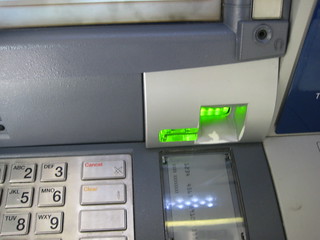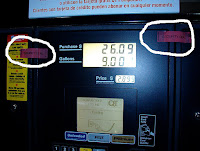RVtravel.com editor Chuck Woodbury and Seattle RV Show Director Dave Helgeson discuss how much it costs to RV. In this segment they focus on how affordable it can be, although they agree that and RVer can spend as much buying an RV and using it as they wish based on their finances, circumstances and needs.
Frugal RVing
Huge RV parts & accessories store!
You have never seen so many RV parts and accessories in one place! And, Wow! Check out those low prices! Click to shop or browse!
You have never seen so many RV parts and accessories in one place! And, Wow! Check out those low prices! Click to shop or browse!
Friday, January 22, 2016
Monday, August 17, 2015
Protect yourself from "card skimmers"
RVers, who travel extensively and rely on gas pumps and ATMs, may be more at risk than the average guy when it comes to card skimming crooks. Card skimmers take your credit or debit card information right off the card's magnetic strip and use it to rob your accounts.
Some who've been victimized by skimmers wonder how their cards were compromised, as many are careful never to let their card out of their possession. But skimming crooks are clever, and by using modern technology, don't need you to hand over your card. All they need to do is to install a card skimming device over the slot of an ATM or fuel pump. Then, when the victim swipes their card, the crook's skimmer nabs the information.
In the early days of skimming, the bad guys also had to set up a hidden camera to be able to record the victim's 4-digit PIN code. Armed with the PIN code and the magnetic strip information, the thief had all that was required to compromise a bank or credit card account. To thwart the crooks at, say, an ATM, even if a skimmer was attached to the machine, by simply covering the key pad with your other hand while entering your PIN you could effectively block the view of the spy camera. No PIN number, no matter if the magnetic data was captured, it's useless to the thief.
But authorities report that card skimming crooks have gotten smarter. In addition to mounting a card skimmer on an ATM slot, clever crooks are also installing a keypad overlay. Mounted directly over the ATM's existing keypad, the crook's overlay simply records your keystrokes as you enter your PIN code, and, presto! No matter if you cover the view of the keypad, all of your information has been compromised. Other advances in crooked technology include skimmers that transmit your data electronically – the thief doesn't have to come back to the crime scene to pick up his equipment to get your data – he just receives it electronically, from a safe distance.
So what are we to do to protect ourselves – and our financial accounts? It's getting more important to use that inner sense of "something's not right here." We have the innate ability to see when something just doesn't look or feel right. Here are some tips:
When using an ATM, look closely before you insert your card. If something looks different, the materials used are a different color or make, if the graphics on the machine are lining up, it's a tip someone may have tampered with the machine. Before you insert your card, touch the keypad. Does it "feel" hinky? Maybe it's too thick? That's a sign there could be a keypad overlay device in place. If there's more than one ATM at the site, compare the two – if one looks different than the other in some way, it may be best not to use either one.
Many fuel pumps are now using tamper evident seals. If the pump has been opened, the seals will either be broken, or may show different writing that advises that the seal has been tampered with. Don't use a pump with a broken or tampered seal. The same about making comparisons to other pumps works here too. It's unlikely that skimmers have compromised more than one pump – so if the pump looks different in any way – particularly with the card reader slot or the keypad – pay inside.
With pumps or ATMs, give the parts a good wiggle. These machines are built solidly, and if the card slot or the keypad has "give" when you grab it and give it a pull and a shake, something may be amiss.
When using a fuel pump, you're better off using a credit card, or use your debit card as a credit card. It's much safer to have to enter your zip code than your 4-digit pin code. And you're generally safer going inside to pay, rather than paying at the pump. Although some crooks have been able to compromise in-the-store card readers, it happens far less often.
And by all means, keep a close watch on your credit and bank account records. If you have online access to your accounts, check them regularly for any suspicious activity – and if you find it, report it immediately. Even if your card is compromised, you're not responsible for the charges, provided you report them in a timely fashion.
photos: ATM -- angusf on flickr.com Fuel pump seal -- Average Jane on flickr.com
In the early days of skimming, the bad guys also had to set up a hidden camera to be able to record the victim's 4-digit PIN code. Armed with the PIN code and the magnetic strip information, the thief had all that was required to compromise a bank or credit card account. To thwart the crooks at, say, an ATM, even if a skimmer was attached to the machine, by simply covering the key pad with your other hand while entering your PIN you could effectively block the view of the spy camera. No PIN number, no matter if the magnetic data was captured, it's useless to the thief.
But authorities report that card skimming crooks have gotten smarter. In addition to mounting a card skimmer on an ATM slot, clever crooks are also installing a keypad overlay. Mounted directly over the ATM's existing keypad, the crook's overlay simply records your keystrokes as you enter your PIN code, and, presto! No matter if you cover the view of the keypad, all of your information has been compromised. Other advances in crooked technology include skimmers that transmit your data electronically – the thief doesn't have to come back to the crime scene to pick up his equipment to get your data – he just receives it electronically, from a safe distance.
So what are we to do to protect ourselves – and our financial accounts? It's getting more important to use that inner sense of "something's not right here." We have the innate ability to see when something just doesn't look or feel right. Here are some tips:
 |
| Materials and color different -- could be a skimmer. |
 |
| Tamper evident fuel pump seals |
With pumps or ATMs, give the parts a good wiggle. These machines are built solidly, and if the card slot or the keypad has "give" when you grab it and give it a pull and a shake, something may be amiss.
When using a fuel pump, you're better off using a credit card, or use your debit card as a credit card. It's much safer to have to enter your zip code than your 4-digit pin code. And you're generally safer going inside to pay, rather than paying at the pump. Although some crooks have been able to compromise in-the-store card readers, it happens far less often.
And by all means, keep a close watch on your credit and bank account records. If you have online access to your accounts, check them regularly for any suspicious activity – and if you find it, report it immediately. Even if your card is compromised, you're not responsible for the charges, provided you report them in a timely fashion.
photos: ATM -- angusf on flickr.com Fuel pump seal -- Average Jane on flickr.com
Subscribe to:
Posts (Atom)